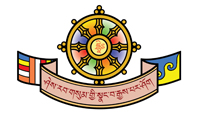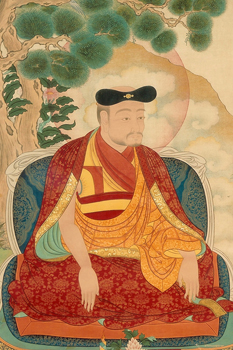20. 1st Gyaltsab 1427 - 1489
|
“You who promote profound brilliant realization, Great Lord Goshri, I supplicate you.” - “Supplication to the Kagyü Gurus”
The First Gyaltsab Rinpoche, Päljor Döndrub, was born at Nyemo in Central Tibet. Under the guidance of the Sixth Gyalwa Karmapa, Thongwa Dönden, he received the transmissions of the Kangyur, Tengyur, and sacred texts of the great Kagyü masters. His Holiness trained him fully in Buddhist philosophy and meditation. Bengar Jampäl Zangpo, one of the heart-sons and spiritual heirs of His Holiness the Sixth Gyalwa Karmapa and Root Guru of the Seventh Karmapa, was also the teacher of Lord Goshri.
In the life-story of the Sixth Karmapa (available to visitors of this website), we learned that the Sixth Gyalwa Karmapa went into retreat when he clearly saw that he did not have long to live. He designated Päljor Döndrub as his regent and gave him the title Gyaltsab, which means “regent” or “crown prince.” So, at the age of 14, Päljor Döndrub became the First Gyaltsab Rinpoche. Ever since, His Eminence Gyaltsab Rinpoche has been one of Four Regents of the Karma Kagyü Lineage, responsible to ensure the continuity of the Kagyü Transmission Lineage in periods between the incarnation of the Karmapa. He built an own monastery, Chögar Gong, directly behind Tsurphu Monastery. Therefore, His Eminence is known as Tsurphu Gyaltsab Rinpoche in Tibet. The Sixth Gyalwa Karmapa had also indicated to him where he would be reborn. His Eminence later became a main teacher of the Seventh Karmapa, Chödrag Gyatso, and imparted the full Kagyü Lineage transmissions to him.
We learned that the Third Karmapa had presented a Red Hat Crown to Dragpa Senge in the earlier article on Khachö Wangpo. In the article offered by Simhanada, entitled “The Black and Red Crowned Lamas,” it is stated that in turn for receiving the Black Vajra Crown from Emperor Yongle, “the Gyalwa Karmapa bestowed upon the heads of his disciples crowns which represent their spiritual qualities. The Red Vajra Crowns of the Tai Situ Rinpoche and Gyaltsab Rinpoche continue to benefit others through their presentation. These Red Crowns represent the enlightened qualities of the Tai Situpa and Gyaltsabpa and also their inseparability from the Gyalwa Karmapa as spiritual father and sons. The Black Crown of the Karmapa and the Red Crown of the Tai Situpa and Gyaltsabpa represent all their qualities, including the nature of the mind, the four immeasurables, the five Buddha families and activities, and the three bodies of the Buddha. Any of these, however, are surpassed by the precious Black Vajra Crown of the Gyalwa Karmapa.” When he was 62 years old, Päljor Döndrub passed into Parinirvana with many wondrous signs of accomplishment. At that time, the Seventh Karmapa had just turned twenty-five. Jamgon Kongtrul Lodrö Thaye wrote: “Five incarnations of Goshir Gyaltsab (the embodiment of the bodhisattva) Vajra-in-Hand (Vajrapani), have appeared (since Päljor Döndrub until Norbu Zangpo). The victor, (the bodhisattva) Loving-Kindness (Maitreya incarnate), Kenting Tai Situ, has appeared in six incarnations who possessed the eyes of the Buddha’s teaching and six who possessed a lotus tongue. (Editors note: According to Kongtrul, his spiritual master, Payma Nyingjay Wangpo, was the twelfth Tai Situ.) As well, there have been the series of incarnations of the illustrious Pawo and Trayo Rinpochays.”
Jamgon Kongtrul continued: “This father (Karmapa) and five sons were mentioned in various treasure texts by the great (master) from Oddiyana (Guru Rinpochay). He also expressed abundant praise for their ability to place others on the stage of non-regression to cyclic existence through being seen, heard, or remembered, or through their touch. These are not just words from a book: these masters are not ordinary persons of limited experience devoid of outstanding qualities or unable to help others. Those among them who have appeared as scholars have been (of an erudition) identical with that of the great leaders of Indian Buddhism. Those among them who have appeared as meditators have not been satisfied with slight signs of success on the spiritual path but have attained the exalted state of great vajra masters.”
There have been twelve incarnations of His Eminence. They are: Ist Gyaltsab Rinpoche – Päljor Döndrub, 20 th Lineage-holder of the Kagyü Golden Rosary; IInd Gyaltsab - Tashi Namgyal (1490-1518); IIIrd Gyaltsab - Goshri Dragpa Päljor (1519-1549); IVth Gyaltsab - Goshri Dragpa Döndrub (1550-1617); Vth Gyaltsab - Dragpa Chöyang (1618-1658); VIth Gyaltsab - Norbu Zangpo (1659-1698); VIIth Gyaltsab - Konchog Özer (1699-1765); VIIIth Gyaltsab - Goshri Chöpel Zangpo (1766-1820); IXth Gyaltsab - Yeshe Zangpo, also known as Dragpa Yeshe (1821-1876); Xth Gyaltsab - Tenpe Nyima (1877-1901); XIth Gyaltsab - Dragpa Gyatso (1902-1953); XIIth Gyaltsab - Dragpa Tenpe Yarpel, also known as Tenzin Trinley Chökyi Nyima (b. 1954).
The short prayer for His Eminence, the present Twelfth Gyaltsab Rinpoche: “From the pinnacle of all that is good in both Samsara and Nirvana As the expression of the blessing of the Three Jewels and Roots,
References: Kagyu Office of His Holiness the 17th Gyalwang Karmapa, Ogyen Trinley Dorje, “The Golden Rosary” (2008). Jamgon Kongtrul Lodrö Thaye, “Jamgon Kongtrul’s Retreat Manual,” transl. & intr. by Ngawang Zangpo, Tsadra Foundation, N.Y. & Colorado, 1994, pages 76-77. Karma Triyana Dharmachakra, “The Twelfth Goshir Gyaltsap Rinpoche,” N.Y. (2008). Simhanada, “Lineages – The First Gyaltsabpa Paljor Dondrub” & “The Black and Red Crowned Lamas” (2008). RywikiTsadraOrg, “Tibetan-English Dictionary, Dharma Glossaries, and Resources,” Nepal (2008).
“May the Doctrine, the only remedy for suffering,the source of every bliss and happiness,b e nurtured and upheld with reverence, and throughout a vast continuance of time, endure!” -- Shantideva
|


